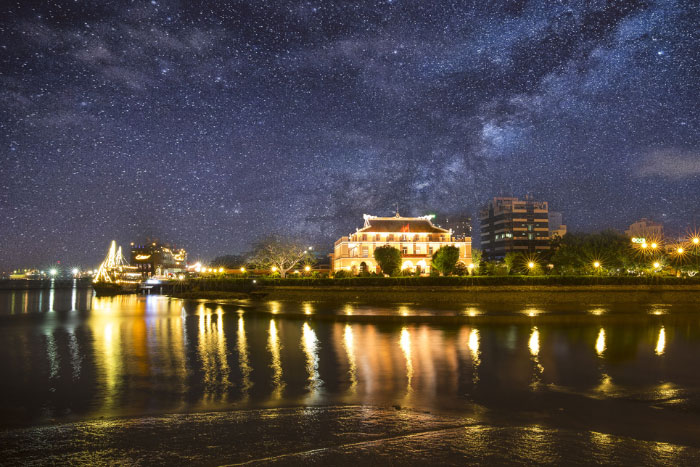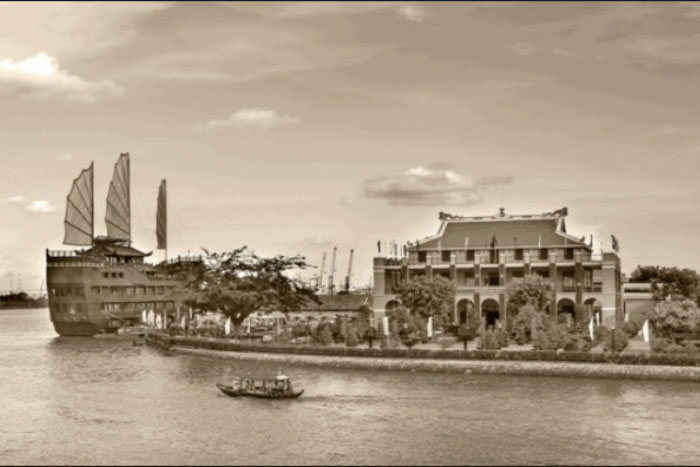Take A Look At Saigon History At Nha Rong Port
Sunday, June 30, 2024
Places to visit & things to do

Welcome to our blog, where we embark on a captivating exploration of Nha Rong Port, a place deeply intertwined with the remarkable life of President Ho Chi Minh. Nestled along the scenic Saigon River in District 4 of Ho Chi Minh City, this architectural gem holds a significant place in Vietnamese history and serves as a poignant reminder of the country's struggle for independence.
1. What is Nha Rong port

Nha Rong Port, also known as the Ho Chi Minh Museum - Ho Chi Minh City Branch, is a historic landmark located in District 4 of Ho Chi Minh City, Vietnam. It holds great significance in Vietnamese history, particularly in relation to President Ho Chi Minh and the country's struggle for independence.
Originally the headquarters of the Messageries maritimes shipping company from 1864 to 1955, Nha Rong Port witnessed the bustling maritime activities of Saigon during that period. However, its prominence stems from a pivotal event that occurred on June 5, 1911. On this significant day, a young man named Nguyen Tat Thanh, later known as President Ho Chi Minh, departed from Nha Rong Port on the Amiral Latouche-Tréville ship, embarking on a transformative journey to Europe. This voyage marked the beginning of his revolutionary path towards national liberation.
In 1975, the Vietnamese government transformed the remnants of Ben Nghe Port into the Ho Chi Minh Memorial Area. This sacred space serves as a tribute to President Ho Chi Minh's unwavering dedication to the country's freedom. Nha Rong Museum, located within the memorial area, offers visitors a comprehensive understanding of President Ho Chi Minh's life and legacy through exhibits showcasing personal artifacts, photographs, and multimedia presentations.
Nha Rong harbour has several theories behind its name. One theory suggests that it originated from the two large clay dragons (Rong) affixed to the roof of the Messageries maritimes headquarters. Another theory mistakenly links the name to "Gia Long," the first emperor of the Nguyen Dynasty, due to a misunderstanding of homophonic words. However, the most widely accepted and common name for the site remains "Nha Rong Port."

Today, Nha Rong Port stands as a renowned historical site, closely associated with President Ho Chi Minh's monumental journey to seek the salvation of Vietnam. It has become an emblematic symbol of Ho Chi Minh City, carrying immense historical and cultural significance. The port's transformation into the Ho Chi Minh Memorial Area, featuring the Nha Rong Museum, preserves the memory and achievements of President Ho Chi Minh, safeguarding valuable materials and artifacts related to his revolutionary activities.
2. The history and significant of Nha Rong Port

Upon gaining control of Cochinchina, the French military embarked on the construction of the Saigon Commercial Port (Port de Commerce de Saigon) to establish a vital trade gateway with the international community. The esteemed maritime transport company, Messageries impériales, was entrusted with the task of building this significant port. The initial port terminals were erected near the Saigon Naval Shipyard (arsenal de Saigon), close to Ben Thanh, and took nearly a year to complete.
To facilitate efficient port management, a headquarters building for Messageries maritimes was constructed on March 4, 1863. This building served as the residence for the General Manager and also housed the ticket office. The construction was overseen by a dedicated official named Domergue. In October 1865, the company added a towering steel flagpole, standing at 40 meters tall, at the former Thủ Ngữ fort. This impressive flagpole served as a signal for vessels entering and leaving the port, and it became known among the locals as the Flagpole of Thu Ngu. In 1893, the Messageries maritimes building embraced modernity with the installation of electric lights. Equipped with 16-candle bulbs, this lighting system was considered a remarkable feat, although it still fell short compared to the oil lamps that adorned the bustling Catina Street (now Đồng Khởi Street) in the city center.
Towards the end of 1899, the company obtained permission to construct docks for ship docking. Sturdy wooden docks were laid on iron pillars, extending 42 meters into the water from the riverbank towards the ships. There was an 18-meter gap between each dock, with a width of 8 meters facing the shore. A 10-meter-wide bridge connected the shore to the docks. Initially, two docks were built, and later a third dock was added. In 1919, the company was granted the opportunity to construct reinforced concrete and steel docks. However, due to various constraints, this project could not be realized until March 1930 when a new dock, measuring an impressive 430 meters in length, was finally completed.
Following the events of 1955, the government of the Republic of Vietnam (South Vietnam) embarked on the renovation of the Messageries maritimes building. The roof was meticulously restored, and the two original dragons were replaced with new ones, depicting them facing outward. Subsequently, in 1965, the building was repurposed as the headquarters for the US Military Assistance Command's Reception Center. In the aftermath of 1975, the management of the iconic Saigon port building, representing a lasting symbol of the city's maritime heritage, was entrusted to the Vietnam Maritime Administration.

In the early 20th century, Nha Rong Port became a pivotal destination in the history of Vietnam. It was here, in 1911, that a young Nguyen Tat Thanh, later known as Ho Chi Minh, made a fateful decision that would alter the course of his life and the destiny of his nation. Leaving behind his teaching job at School Dục Thanh, he arrived at Nha Rong wharf and assumed the alias "Anh Ba" to work as a laborer. Little did he know that this humble port would become the incubator for his revolutionary spirit.
During his time at Nha Rong Port, Ho Chi Minh tirelessly toiled alongside fellow workers, all the while harboring a fervent desire to liberate his country from the shackles of colonial rule. It was within the bustling atmosphere of the port that he began sowing the seeds of change. Ho Chi Minh, driven by his passion for justice and equality, took it upon himself to educate and empower the workers around him. He taught them to read and write, fostering a spirit of resistance and awakening a collective consciousness that would later shape the course of Vietnam's independence movement.
The incredible story of Ho Chi Minh's time at Nha Rong Port is poignantly captured in the book "The Green Lotus Bud." This literary masterpiece chronicles his experiences, shedding light on the transformative moments that unfolded within the port's bustling confines. Through his teachings and acts of solidarity, Ho Chi Minh not only empowered the workers but also instilled in them a sense of pride and determination to fight for their rights. His time at Nha Rong Port became a crucible of enlightenment, where the seeds of Vietnam's struggle for independence were sown.
The legacy of Nha Rong harbour lives on as a testament to the indomitable spirit of the Vietnamese people and their relentless pursuit of freedom. Today, the port stands as the Ho Chi Minh Museum, preserving the historical significance of this transformative period. Visitors can explore the exhibits, delve into the life of Ho Chi Minh, and witness firsthand the impact that Nha Rong Port had on his revolutionary journey. It serves as a reminder of the sacrifices made and the ideals that fueled Vietnam's fight for independence, inspiring future generations to embrace the spirit of unity and resilience.
3. Tips before visit this destination
If you're planning to visit the Nha Rong harbour in Ho Chi Minh City, Vietnam, here are some tips to help make your visit enjoyable:
- Location: The Nha Rong wharf , also known as the Ho Chi Minh Museum, is situated in District 4 of Ho Chi Minh City. It's located on the banks of the Saigon River, offering beautiful views of the waterfront.
- Opening Hours: The Nha Rong wharf is open to visitors from Tuesday to Sunday, typically from morning to late afternoon. Check the museum's official website for the most up-to-date opening hours and any special closures.
- Museum Admission: There may be an entrance fee to visit the Ho Chi Minh Museum. Check the current admission fees and any discounts available, especially for students, seniors, or groups.
- Guided Tours: Consider joining a guided tour of the museum. It can provide valuable insights into the exhibits, the history of Ho Chi Minh City, and the life of Ho Chi Minh himself. Guided tours may be available in multiple languages, so check in advance.
- Exhibits and Displays: The Nha Rong Port is dedicated to the life and work of Ho Chi Minh, the revered leader of Vietnam. Explore the exhibits that showcase historical artifacts, photographs, and multimedia presentations to gain a deeper understanding of his role in the country's history.
- Architecture and Views: Take some time to appreciate the architectural beauty of the Nha Rong Port building. It is a blend of French colonial and traditional Vietnamese styles. Enjoy the views of the Saigon River from the port's balcony or terrace.
- Ho Chi Minh Statue: Outside the museum, you'll find a statue of Ho Chi Minh. Take a moment to observe and learn about the significance of this iconic figure in Vietnamese history.
- Photography: Capture the unique ambiance and architectural details of the Nha Rong Port. However, be mindful of any photography restrictions inside the museum and respect the privacy of other visitors.
- Nearby Attractions: The Nha Rong wharf is located near other popular attractions in Ho Chi Minh City. Consider exploring the nearby Ben Thanh Market, Nguyen Hue Walking Street, or the Bitexco Financial Tower for a well-rounded experience.
- Transportation: Reach the Nha Rong Port by taxi, ride-sharing apps, or public transportation. It's advisable to check the best transportation options based on your location and the traffic conditions in the city.
Remember to observe the museum's rules and regulations, and be respectful of the historical significance of the Nha Rong Port as you explore the exhibits and learn more about the life of Ho Chi Minh.
4. Frequently asked question about Nha Rong port
Are there any attractions worth visiting near Nha Rong Port?
Yes, there are several attractions worth visiting in the vicinity of the Nha Rong harbour. Some popular nearby attractions include the Ben Thanh Market, Nguyen Hue Walking Street, Bitexco Financial Tower, and the Saigon Opera House. These attractions offer a diverse range of experiences and can be included in your itinerary.
Is the Nha Rong Port accessible for people with disabilities?
The accessibility of the Nha Rong Port for people with disabilities may vary. It's recommended to contact the museum directly or check their website for information on accessibility features and facilities available to accommodate visitors with disabilities.
How long does it take to explore the Nha Rong Port?
The time required to explore the museum can vary depending on your level of interest and engagement. On average, visitors spend around 1-2 hours exploring the exhibits and learning about Ho Chi Minh's life and contributions to Vietnam's history.
By following these tips, you can make the most of your visit to Nha Rong wharf and enjoy all that this historic landmark has to offer. If an authentic trip to Nha Rong Port is what you are after, then don't hesitate to contact us : AUTOUR ASIA - Vietnam Travel Agency to ensure you the voyage of your dream.
Take a look at
>>> Unique things to to in Saigon
>>>Ho Chi Minh City Travel Guide
>>>South Vietnam Tour
>>>Sounthen Vietnam Tour 8 Days
>>> Unique things to to in Saigon
>>>Ho Chi Minh City Travel Guide
>>>South Vietnam Tour
>>>Sounthen Vietnam Tour 8 Days
Related travel guide
Other similar articles
CUSTOMIZABLE BY LOCAL EXPERTS
Personalized trip at the original price!
REFUND GUARANTEE
We believe in our work and promise to give you money back.
GOOD PRICE / QUALITY
95% satisfied more than expected!
24/7 LOCAL SUPPORT
We are always available online to provide assistance at any time.
Most read articles
Autour Asia is highly recommended on
Embracing the mission of "Satisfied more than expected" and providing authentic experiences, we have received numerous recommendations on reputable travel forums:























